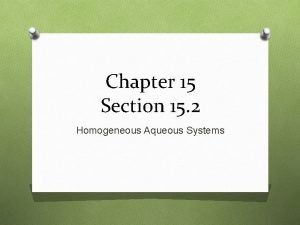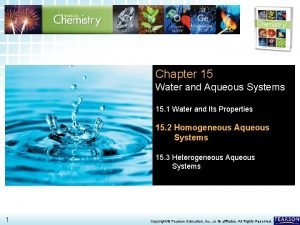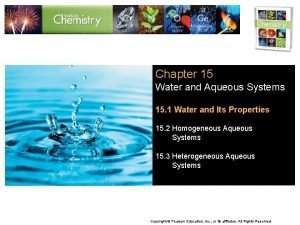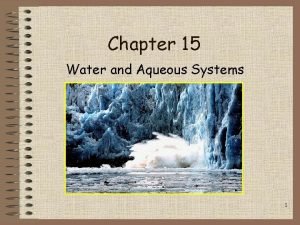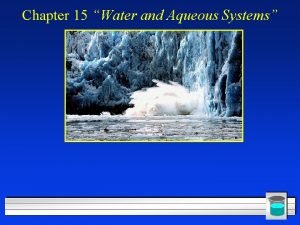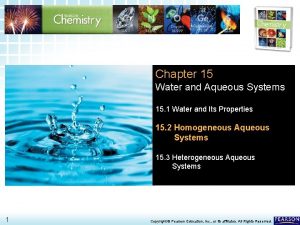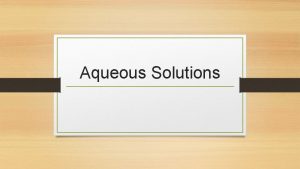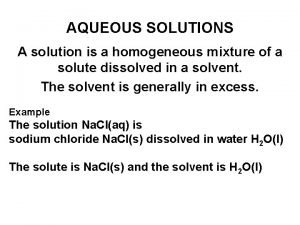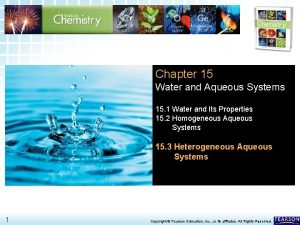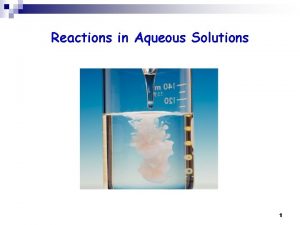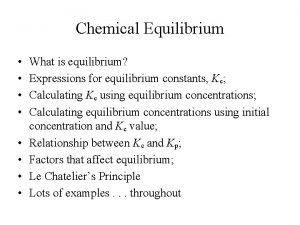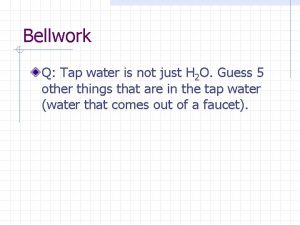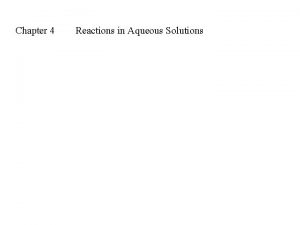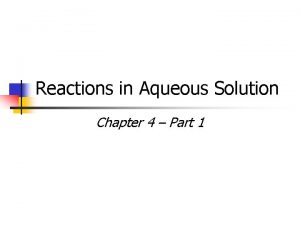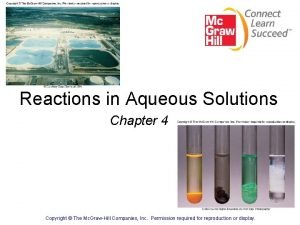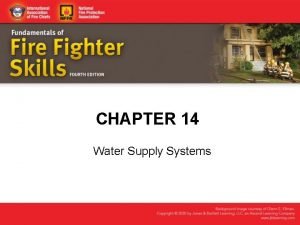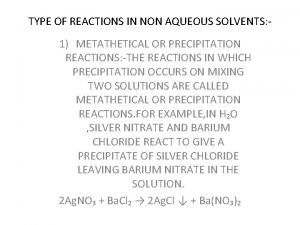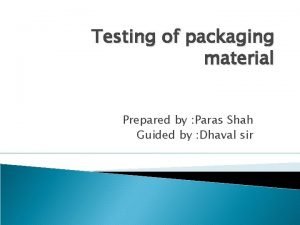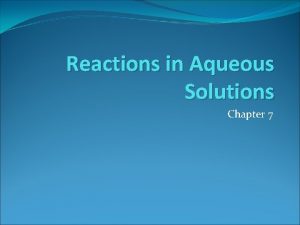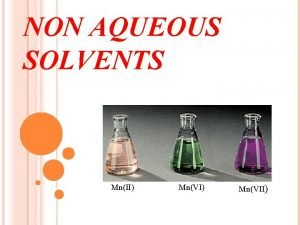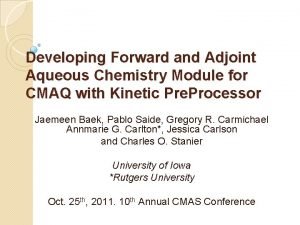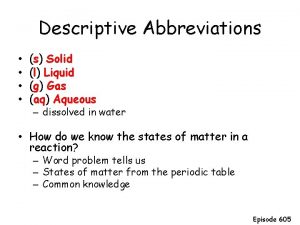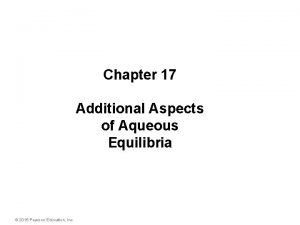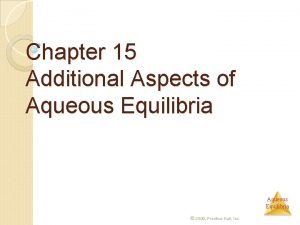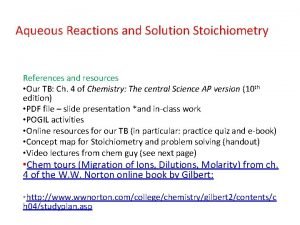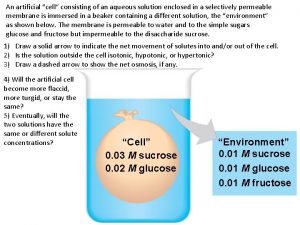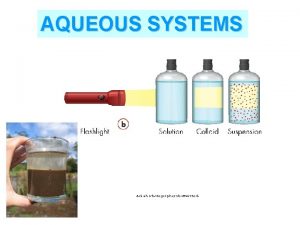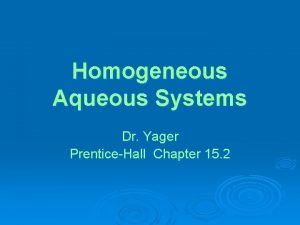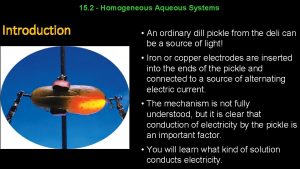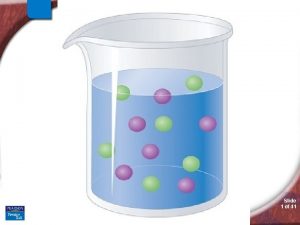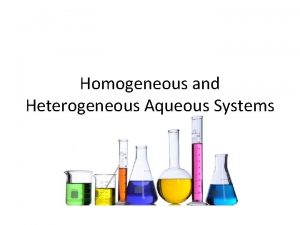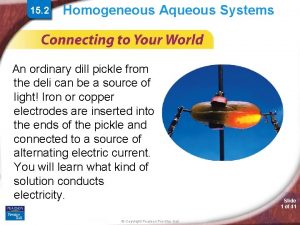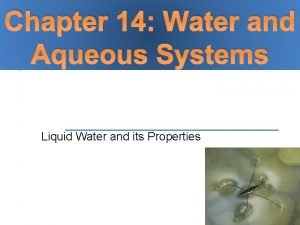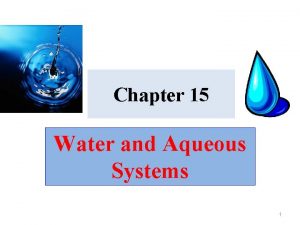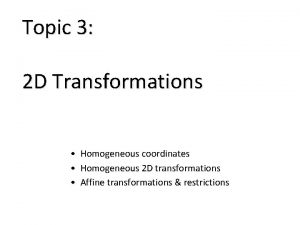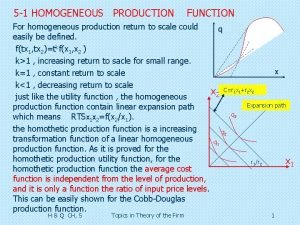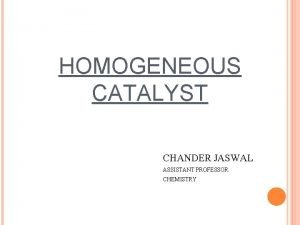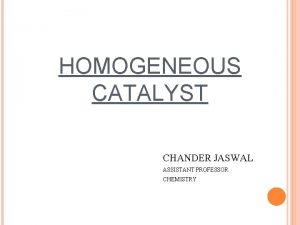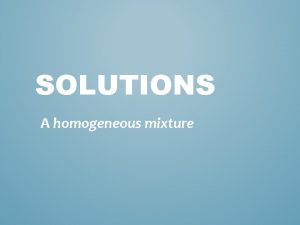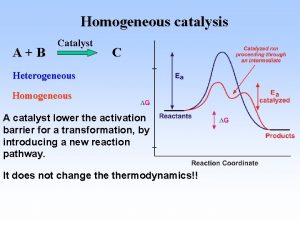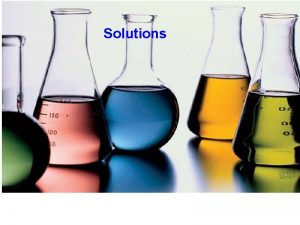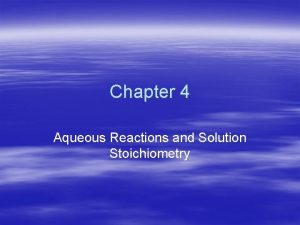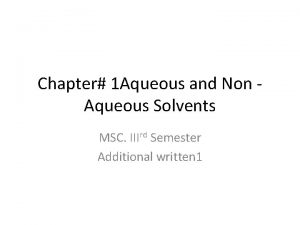15 2 Homogeneous Aqueous Systems Chapter 15 Water
































- Slides: 32

15. 2 Homogeneous Aqueous Systems > Chapter 15 Water and Aqueous Systems 15. 1 Water and Its Properties 15. 2 Homogeneous Aqueous Systems 15. 3 Heterogeneous Aqueous Systems 1 Copyright © Pearson Education, Inc. , or its affiliates. All Rights Reserved.

15. 2 Homogeneous Aqueous Systems > How can you make a pickle glow? Although it sounds absurd, an ordinary dill pickle from the deli can be a source of light when connected to an electric current! 2 Copyright © Pearson Education, Inc. , or its affiliates. All Rights Reserved.

15. 2 Homogeneous Aqueous Systems > Solutions Solvents and Solutes • In a solution, the dissolving medium is the solvent. • The dissolved particles in a solution are the solute. 3 Copyright © Pearson Education, Inc. , or its affiliates. All Rights Reserved.

15. 2 Homogeneous Aqueous Systems > Solutions Solvents and Solutes • A solvent dissolves the solute. • The solute becomes dispersed in the solvent. • Solvents and solutes may be gases, liquids, or solids. 4 Copyright © Pearson Education, Inc. , or its affiliates. All Rights Reserved.

15. 2 Homogeneous Aqueous Systems > Solutions Solvents and Solutes • Solutions are homogeneous mixtures. • Solute particles can be atoms, ions, or molecules. • If you filter a solution through filter paper, both the solute and solvent pass through the filter. 5 Copyright © Pearson Education, Inc. , or its affiliates. All Rights Reserved.

15. 2 Homogeneous Aqueous Systems > Solutions Solvents and Solutes Substances that dissolve most readily in water include ionic compounds and polar covalent compounds. • Nonpolar covalent compounds, such as methane, and compounds found in oil, grease, and gasoline, do not dissolve in water. • However, oil and grease will dissolve in gasoline. 6 Copyright © Pearson Education, Inc. , or its affiliates. All Rights Reserved.

15. 2 Homogeneous Aqueous Systems > Solutions The Solution Process • A water molecule is polar, with a partial negative charge on the oxygen atom and partial positive charges on the hydrogen atoms. • As individual solute ions break away from the crystal, the negatively and positively charged ions become surrounded by solvent molecules and the ionic crystal dissolves. 7 Copyright © Pearson Education, Inc. , or its affiliates. All Rights Reserved.

15. 2 Homogeneous Aqueous Systems > Solutions The Solution Process Solvated ions The process by which the positive and negative ions of an ionic solid become surrounded by solvent molecules is called solvation. Surface of ionic solid 8 Copyright © Pearson Education, Inc. , or its affiliates. All Rights Reserved.

15. 2 Homogeneous Aqueous Systems > Solutions The Solution Process • Polar solvents such as water dissolve ionic compounds and polar compounds. • Nonpolar solvents such as gasoline dissolve nonpolar compounds. 9 • This relationship can be summed up in the expression “like dissolves like. ” Copyright © Pearson Education, Inc. , or its affiliates. All Rights Reserved.

15. 2 Homogeneous Aqueous Systems > Electrolytes and Nonelectrolytes Why are all ionic compounds electrolytes? • An electrolyte is a compound that conducts an electric current when it is in an aqueous solution or in the molten state. 10 Copyright © Pearson Education, Inc. , or its affiliates. All Rights Reserved.

15. 2 Homogeneous Aqueous Systems > Electrolytes and Nonelectrolytes In order for the bulb to light, an electric current must flow between the two electrodes that are immersed in the solution. • Sodium chloride, a strong electrolyte, is nearly 100% dissociated into ions in water. To (+) electrode 11 To (–) electrode Copyright © Pearson Education, Inc. , or its affiliates. All Rights Reserved.

15. 2 Homogeneous Aqueous Systems > Electrolytes and Nonelectrolytes In order for the bulb to light, an electric current must flow between the two electrodes that are immersed in the solution. • Mercury(II) chloride, a weak electrolyte, is only partially dissociated in water. To (+) electrode 12 To (–) electrode Copyright © Pearson Education, Inc. , or its affiliates. All Rights Reserved.

15. 2 Homogeneous Aqueous Systems > Electrolytes and Nonelectrolytes In order for the bulb to light, an electric current must flow between the two electrodes that are immersed in the solution. • Glucose, a nonelectrolyte, does not dissociate in water. • A nonelectrolyte is a compound that does not conduct an electric current in either an aqueous solution or the molten state. To (+) electrode 13 To (–) electrode Copyright © Pearson Education, Inc. , or its affiliates. All Rights Reserved.

15. 2 Homogeneous Aqueous Systems > Electrolytes and Nonelectrolytes Some polar molecular compounds are nonelectrolytes in the pure state but become electrolytes when they dissolve in water. • For example, ammonia (NH 3(g)) is not an electrolyte in the pure state. • Yet an aqueous solution of ammonia conducts an electric current because ammonium ions (NH 4+) and hydroxide ions (OH–) form when ammonia dissolves in water. NH 3(g) + H 2 O(l) NH 4+(aq) + OH–(aq) 14 Copyright © Pearson Education, Inc. , or its affiliates. All Rights Reserved.

15. 2 Homogeneous Aqueous Systems > Electrolytes and Nonelectrolytes Not all electrolytes conduct electric current to the same degree. • In a solution that contains a strong electrolyte, all or nearly all of the solute exists as ions. • A weak electrolyte conducts an electric current poorly because only a fraction of the solute in the solution exists as ions. 15 Copyright © Pearson Education, Inc. , or its affiliates. All Rights Reserved.

15. 2 Homogeneous Aqueous Systems > Electrolytes and Nonelectrolytes Your cells use electrolytes, such as sodium and potassium ions, to carry electrical impulses across themselves and to other cells. • An electrolyte imbalance can occur if you become dehydrated. • When you exercise, you can lose water and electrolytes from your body through perspiration. 16 Copyright © Pearson Education, Inc. , or its affiliates. All Rights Reserved.

15. 2 Homogeneous Aqueous Systems > Hydrates The water contained in a crystal is called the water of hydration or water of crystallization. • A compound that contains water of hydration is called a hydrate. 17 Copyright © Pearson Education, Inc. , or its affiliates. All Rights Reserved.

15. 2 Homogeneous Aqueous Systems > Hydrates The forces holding the water molecules in hydrates are not very strong, so the water is easily lost and regained. • A substance that is anhydrous does not contain water. 18 Copyright © Pearson Education, Inc. , or its affiliates. All Rights Reserved.

15. 2 Homogeneous Aqueous Systems > Hydrates Cu. SO 4 5 H 2 O(s) Heating of a sample of blue Cu. SO 4 5 H 2 O begins. 19 + heat – heat Cu. SO 4(s) + 5 H 2 O(g) After a time, much of the blue hydrate has been converted to white anhydrous Cu. SO 4. Copyright © Pearson Education, Inc. , or its affiliates. All Rights Reserved.

15. 2 Homogeneous Aqueous Systems > Hydrates To determine what percent by mass of a hydrate is water: • First determine the mass of water in one mole of hydrate. • Then determine the molar mass of the hydrate. • The percent by mass of water can be calculated using the following equation: mass of water Percent by mass H 2 O = mass of hydrate 100% 20 Copyright © Pearson Education, Inc. , or its affiliates. All Rights Reserved.

15. 2 Homogeneous Aqueous Systems > Hydrates Efflorescent Hydrates The water molecules in hydrates are held by weak forces, so hydrates often have an appreciable vapor pressure. • If a hydrate has a vapor pressure higher than the pressure of water vapor in the air, the hydrate will lose its water of hydration, or effloresce. 21 Copyright © Pearson Education, Inc. , or its affiliates. All Rights Reserved.

15. 2 Homogeneous Aqueous Systems > Hydrates Hygroscopic Hydrates Hydrated ionic compounds that have low vapor pressure remove water from moist air to form higher hydrates. • These hydrates and other compounds that remove moisture from air are called hygroscopic. 22 Copyright © Pearson Education, Inc. , or its affiliates. All Rights Reserved.

15. 2 Homogeneous Aqueous Systems > Sample Problem 15. 1 Finding the Percent by Mass of Water in a Hydrate Calculate the percent by mass of water in washing soda, sodium carbonate decahydrate (Na 2 CO 3 10 H 2 O). 23 Copyright © Pearson Education, Inc. , or its affiliates. All Rights Reserved.

15. 2 Homogeneous Aqueous Systems > Sample Problem 15. 1 1 Analyze List the known and the unknown. To determine the percent by mass, divide the mass of water in one mole of the hydrate by the molar mass of the hydrate and multiply by 100%. KNOWN formula of hydrate = Na 2 CO 3 10 H 2 O UNKNOWN percent H 2 O = ? % 24 Copyright © Pearson Education, Inc. , or its affiliates. All Rights Reserved.

15. 2 Homogeneous Aqueous Systems > Sample Problem 15. 1 2 Calculate Solve for the unknown. Determine the mass of 10 mol of water. mass of 10 mol H 2 O = 10[(2 1. 0 g) + 16. 0 g] = 180. 0 g For every 1 mol of Na 2 CO 3 10 H 2 O, there are 10 mol of H 2 O. 25 Copyright © Pearson Education, Inc. , or its affiliates. All Rights Reserved.

15. 2 Homogeneous Aqueous Systems > Sample Problem 15. 1 2 Calculate Solve for the unknown. Determine the mass of 1 mol of the hydrated compound. molar mass of = (2 23. 0 g) + 12. 0 g + (3 16. 0 g) + 180. 0 g Na 2 CO 3 10 H 2 O = 286. 0 g 26 Copyright © Pearson Education, Inc. , or its affiliates. All Rights Reserved.

15. 2 Homogeneous Aqueous Systems > Sample Problem 15. 1 2 Calculate Solve for the unknown. Calculate the percent by mass of water in the hydrate. mass of water percent by mass H 2 O = mass of hydrate 100% 180. 0 g = 286. 0 g 100% = 62. 94% 27 Copyright © Pearson Education, Inc. , or its affiliates. All Rights Reserved.

15. 2 Homogeneous Aqueous Systems > Sample Problem 15. 1 3 Evaluate Does the result make sense? • The mass of the water accounts for more than half the molar mass of the compound. • So, a percentage greater than 50% is expected. 28 Copyright © Pearson Education, Inc. , or its affiliates. All Rights Reserved.

15. 2 Homogeneous Aqueous Systems > Hydrates Deliquescent Compounds Some compounds are so hygroscopic that they become wet when exposed to normally moist air. • These compounds are deliquescent, which means that they remove sufficient water from the air to dissolve completely and form solutions. 29 Copyright © Pearson Education, Inc. , or its affiliates. All Rights Reserved.

15. 2 Homogeneous Aqueous Systems > Hydrates Pellets of sodium hydroxide are deliquescent. The solution formed by a deliquescent substance has a lower vapor pressure than that of the water in the air. 30 Copyright © Pearson Education, Inc. , or its affiliates. All Rights Reserved.

15. 2 Homogeneous Aqueous Systems > BIG IDEA Bonding and Interactions • Ionic compounds and polar covalent compounds dissolve most readily in water to form aqueous solutions. • Ionic compounds dissolve in water when the polar water molecules attract the ions of the solute, causing the individual solute ions to break away from the ionic crystal. 31 Copyright © Pearson Education, Inc. , or its affiliates. All Rights Reserved.

15. 2 Homogeneous Aqueous Systems > END OF 15. 2 32 Copyright © Pearson Education, Inc. , or its affiliates. All Rights Reserved.
 Do pickles conduct electricity
Do pickles conduct electricity Chapter 15 water and aqueous systems
Chapter 15 water and aqueous systems Chapter 15 water and aqueous systems worksheet answers
Chapter 15 water and aqueous systems worksheet answers Water and aqueous systems chapter 15 answers
Water and aqueous systems chapter 15 answers Chapter 15 water and aqueous systems
Chapter 15 water and aqueous systems Chapter 15 water and aqueous systems
Chapter 15 water and aqueous systems Are aqueous solutions homogeneous mixtures
Are aqueous solutions homogeneous mixtures Are aqueous solutions homogeneous mixtures
Are aqueous solutions homogeneous mixtures Non homogeneous differential equation definition
Non homogeneous differential equation definition Water and water and water water
Water and water and water water Heterogeneous aqueous systems
Heterogeneous aqueous systems Is water aqueous
Is water aqueous K equilibrium formula
K equilibrium formula Tap water homogeneous or heterogeneous
Tap water homogeneous or heterogeneous Modern chemistry chapter 13
Modern chemistry chapter 13 Chapter 4 reactions in aqueous solutions
Chapter 4 reactions in aqueous solutions Concentrated solution
Concentrated solution Chapter 4 reactions in aqueous solutions worksheet answers
Chapter 4 reactions in aqueous solutions worksheet answers Dilute solution
Dilute solution The number of tankers needed for a fire will depend on the
The number of tankers needed for a fire will depend on the Class 8 english chapter 7 water water everywhere
Class 8 english chapter 7 water water everywhere Types of reaction in non aqueous solvents
Types of reaction in non aqueous solvents For clarity of aqueous extract test container autoclaved at
For clarity of aqueous extract test container autoclaved at Reactions in aqueous solutions
Reactions in aqueous solutions Balancing redox reactions in acidic solution
Balancing redox reactions in acidic solution Pelarut protonik
Pelarut protonik Liquid ammonia as non aqueous solvent
Liquid ammonia as non aqueous solvent Aqueous solutions module
Aqueous solutions module Solid liquid, gas aqueous chart
Solid liquid, gas aqueous chart Additional aspects of aqueous equilibria
Additional aspects of aqueous equilibria Additional aspects of aqueous equilibria
Additional aspects of aqueous equilibria Aqueous reactions and solution stoichiometry
Aqueous reactions and solution stoichiometry An artificial cell consisting of an aqueous solution
An artificial cell consisting of an aqueous solution
